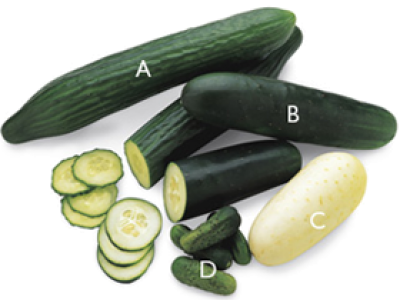Cucumber - Kūkamo
Cucumbers are thought to have originated in Southern Asia and were very popular in India.
They eventually spread to Europe, where for a long time they were used to quench thirst as they contain 96% water. Cucumbers are related to watermelon, and are frequently used in salads, adding an interesting texture. In New Zealand we can buy several varieties of cucumber.
A. Telegraph cucumber
This is the most popular cucumber and is grown under glass. It is long, usually 30–45 cm, and often individually wrapped in plastic because its skin is very soft and is easily damaged. The plastic stops the cucumber drying out and going soft. Telegraph cucumber skin does not need peeling. They are often referred to as seedless because when harvested at their best, the seeds are immature or virtually nonexistent.
B. Short cucumber
Sometimes this is called the standard or stubby cucumber. It is short and has a slightly uneven surface. Grown indoors all year round, it can also be grown outdoors in the summer. The skin on a standard cucumber is tougher than a telegraph cucumber and is usually peeled. For some uses the seeds are also removed.
C. Apple cucumber
This is a pale yellow cucumber with a diameter of around 9 cm and is about 12 cm long. It is crisp like an apple and has a very mild sweet flavour. The skin can be quite hard so it is usually peeled.
D. Gherkin
This is very small, between 5–10 cm long, and is grown only for pickling.
Lebanese cucumber (not shown)
The Lebanese cucumber is green skinned, white fleshed and only 12–15 cm long. It has a juicy texture and a tender skin that does not need to be peeled. They look similar to the mini cucumber (below) but are slightly longer.
Mini or cocktail cucumber (not shown)
Mini or cocktail cucumbers are similar to Lebanese cucumbers. They are green skinned, white fleshed but only 9–11 cm long. They are very sweet and juicy with a tender skin that does not need peeling.
What to look for
Choose cucumbers with a firm skin and an even colour. The shade of the cucumber is important with telegraph and short cucumbers; a vibrant green colour assures the buyer that the cucumbers have recently come from the vine, while a dull green or yellow indicates age.
Availability
Available:
Telegraph – all year
Short and apple cucumber – December to February
Store
Store in the warmest place in the fridge and use promptly. Cooler times of the year they can be stored on the bench. Lebanese cucumbers are always best refrigerated.
How to prepare
Young cucumbers have a mild and tender skin and it is unnecessary to peel them. Telegraph, Lebanese and cocktail cucumbers never need to be peeled. European recipe books may advocate peeling and removing the seeds, but this is not normally necessary.
Ways to eat
Cucumbers are most popular raw as a salad vegetable. Slices of raw cucumber can be used like crackers when serving nibbles with drinks. Cucumbers can also be used in cold soup. They can be chopped and sautéed, or juiced.
Cooking methods
Microwave, sauté, steam, stuff.
Nutrition
Lebanese cucumbers provide almost twice the amount of vitamin C and vitamin A compared to other varieties. Peeling cucumbers reduces the dietary fibre content slightly. Cucumbers have a high water content.
Nutrition table
| CUCUMBER, TELEGRAPH | Raw | |||
| Nutrition Information | ||||
| Servings size: 1/2 cup = 75g | ||||
| Average Quantity | % Daily Intake per serve | Average Quantity | ||
| per serving | per 100g | |||
| Energy (kJ/Cal) | 39/9 | 0% | 51/12 | |
| Protein (g) | 0.6 | 1% | 0.8 | |
| Fat, total (g) | 0 | 0% | 0.0 | |
| - saturated (g) | 0.0 | 0% | 0.0 | |
| Available carbohydrate (g) | 1.4 | 0% | 1.9 | |
| - sugars (g) | 1.4 | 2% | 1.8 | |
| Dietary Fibre (g) | 0.6 | 0.8 | ||
| Sodium (mg) | 1 | 0% | 2 | |
| Vitamin C (mg) | 0.0 | 1% RDI* | 1 | |
| Percentage Daily Intakes are based on an average adult diet of 8700 kJ | ||||
| Your daily Intakes may be higher or lower depending on your energy needs. | ||||
| *Recommended Dietary Intake (Average Adult) | ||||
| Source: FOODfiles 2018 | ||||
Retailing
Display different varieties together on refrigerated shelving. Ensure that the temperature does not fall below 5ºC as chilling injury will occur. Use the QR code on labels.
Store at 10-12ºC with a relative humidity of 90-98%. Lower temperatures will cause chilling damage. Cucumbers are ethylene sensitive so store separately from ethylene producing fruits and vegetables.
Purchase cucumbers with the New Zealand GAP logo.
